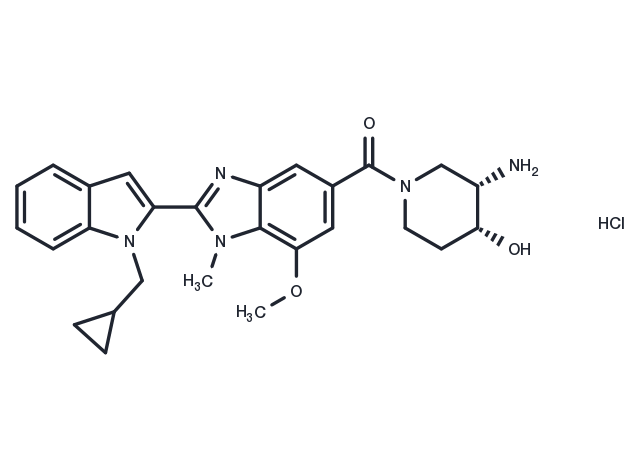Powder: -20°C for 3 years | In solvent: -80°C for 1 year
GSK484 hydrochloride (GTPL8577) (GTPL8577) is a specifc and reversible peptidyl arginine deiminase 4 (PAD4) inhibitor. It demonstrates high-affinity binding to PAD4 with IC50s of 50 nM in the absence of Calcium.

| パッケージサイズ | 在庫状況 | 単価(税別) | |||
|---|---|---|---|---|---|
| サンプルについてお問い合わせ | |||||
| 1 mg | 在庫あり | ¥ 16,000 | |||
| 5 mg | 在庫あり | ¥ 36,500 | |||
| 10 mg | 在庫あり | ¥ 55,000 | |||
| 25 mg | 在庫あり | ¥ 111,000 | |||
| 50 mg | 在庫あり | ¥ 158,500 | |||
| 100 mg | 在庫あり | ¥ 225,500 | |||
| 1 mL * 10 mM (in DMSO) | 在庫あり | ¥ 40,500 | |||
| 説明 | GSK484 hydrochloride (GTPL8577) (GTPL8577) is a specifc and reversible peptidyl arginine deiminase 4 (PAD4) inhibitor. It demonstrates high-affinity binding to PAD4 with IC50s of 50 nM in the absence of Calcium. |
| ターゲット&IC50 | PAD4:50 nM (in 0 mM Calcium), PAD4:50 nM (in 2 mM Calcium) |
| In vitro | GSK484 demonstrates high-affinity binding to the low-calcium form of PAD4 with IC50s of 50 nM and 250 nM in the absence of Calcium (0 mM) and Calcium (2 mM), respectively. GSK484 also inhibits PAD4 citrullination (at 0.2 mM Calcium) of benzoyl-arginine ethyl ester (BAEE) substrate in a concentration-dependent manner [1]. |
| In vivo | To determine if PAD4 inhibition can mitigate cancer-associated kidney damage, MMTV-PyMT mice received the PAD4 inhibitor GSK484 at a dosage of 4 mg/kg daily for one week. This treatment effectively lowered the elevated neutrophil NETosis in the peripheral blood of cancerous mice. Concurrently, there was a significant reduction in the urine protein level of treated MMTV-PyMT mice compared to those untreated, indicating kidney function improvement akin to that achieved with DNase I treatment, without any observed toxicity [2]. |
| キナーゼ試験 | PAD4 is serially diluted in the presence of 10 nM GSK215 in assay buffer (100 mM HEPES, pH 8, 50 mM NaCl, 5% glycerol, 1 mM CHAPS, 1 mM DTT) at varying concentrations of calcium (0, 0.2, 2 and 10 mM). Following incubation for 50 min, apparent Kds for each calcium concentration are determined using a single site saturation curve. For IC50 determination, GSK484 is serially diluted in DMSO (1% final assay concentration) and tested at the same range of calcium concentrations in the presence of PAD4 (at the calculated Kd for each calcium condition) and 10 nM GSK215 in the same assay buffer and volume. Reactions are incubated for 50 min after which IC50 values are calculated using a four-parameter logistic equation [1]. |
| 細胞研究 | HEK293 cells stably expressing N-terminal FLAG-tagged PAD1, PAD2, PAD3 or PAD4 are engineered by retroviral transduction. Cells are grown in 15 cm diameter plates to subconfluency in DMEM supplemented with 10% Foetal Bovine Serum, harvested by centrifugation and washed once in PBS/2 mM EGTA. Cells are lysed in 50 mM Tris-Cl, pH 7.4, 1.5 mM MgCl2, 5% glycerol, 150 mM NaCl, 25 mM NaF, 1 mM Na3VO4, 0.4% NP40, 1 mM DTT with protease inhibitors. Lysates are pre-incubated for 20 min at 4°C with DMSO alone (2%), 100 μM of GSK199, GSK484, GSK106 or 200 μM Cl-amidine. Citrullination reactions are performed for 30 min at 37°C in the presence of 2 mM calcium. Extracts are loaded on to gels, proteins separated by SDS-PAGE and transferred to PVDF membranes. Citrullinated proteins are then chemically modified and detected using an anti-modified citrulline antibody. FLAG-PAD constructs are detected using the anti-FLAG antibody [1]. |
| 動物実験 | The study includes the MMTV-PyMT mouse model for mammary carcinoma (FVB/n background) and the RIP1-Tag2 mouse model for pancreatic neuroendocrine carcinoma (C57BL/6 background). Mice are treated daily by intra-peritoneal injections of the PAD4 inhibitor GSK484 (4 mg/kg). GSK484 is dissolved in 99.9% ethanol at a concentration of 25 mg/mL to generate a stock solution and further diluted 1:50 in 0.9% NaCl shortly before injection of 200 μL/mouse [2]. |
| 別名 | GTPL8577, AOB6992 |
| 分子量 | 510.03 |
| 分子式 | C27H32ClN5O3 |
| CAS No. | 1652591-81-5 |
Powder: -20°C for 3 years | In solvent: -80°C for 1 year
DMSO: 60 mg/mL (117.64 mM), Sonication is recommended.
You can also refer to dose conversion for different animals. 詳細
bottom
Please see Inhibitor Handling Instructions for more frequently ask questions. Topics include: how to prepare stock solutions, how to store products, and cautions on cell-based assays & animal experiments, etc.
GSK484 hydrochloride 1652591-81-5 Chromatin/Epigenetic PAD GTPL8577 AOB6992 GSK 484 Protein Arginine Deiminase GTPL-8577 GSK484 Hydrochloride GTPL 8577 GSK-484 AOB-6992 GSK-484 hydrochloride GSK484 inhibit Peptidylarginine Deiminase GSK 484 Hydrochloride AOB 6992 Inhibitor GSK-484 Hydrochloride inhibitor
